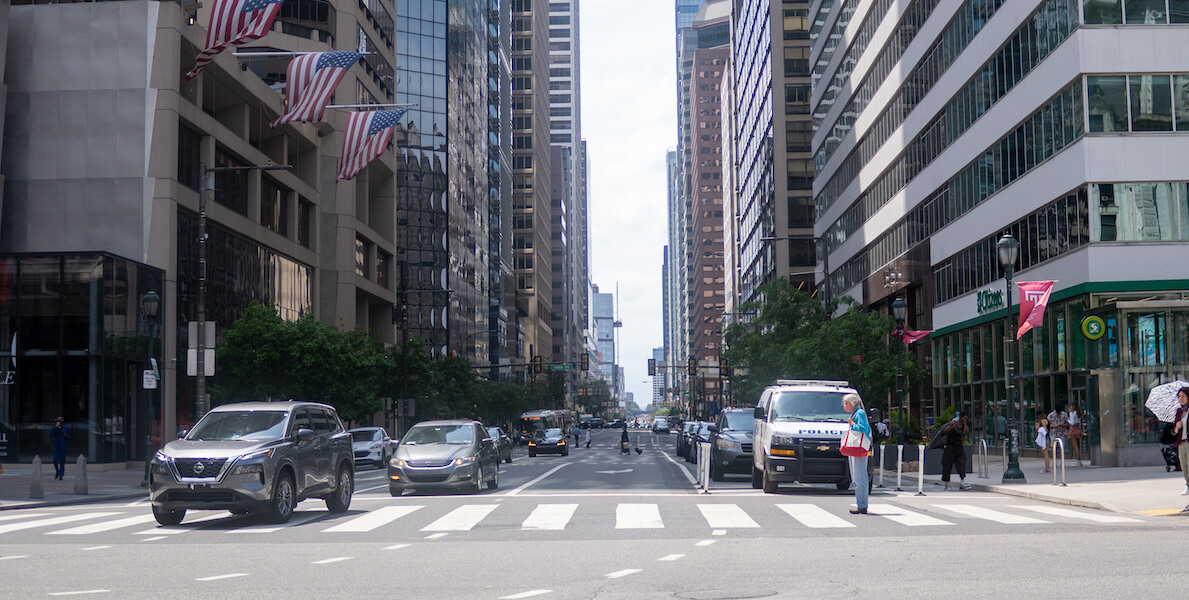Alongside gun violence and the opioid epidemic, traffic crashes in Philadelphia have spiraled out of control in recent years. As the pandemic took hold of so many aspects of our lives, Philadelphia traffic fatalities rose from around 100 people per year pre-pandemic to 152 in 2020 and 133 in 2021, according to Philadelphia Police statistics published by the Bicycle Coalition of Greater Philadelphia. And this year, we are on pace for similar results.
No one is immune from traffic crashes in our city, especially pedestrians. Last year, 44 pedestrians died in vehicular crashes, according to the Bicycle Coalition. The just-released Vision Zero annual report put this statistic into context, “People walking are involved in 15 percent of all crashes but represent 38 percent of all traffic deaths”
In Philadelphia, as well as nationwide, pedestrian victims skew older. A 2013 report from the U.S. Department of Transportation reported that older adults are disproportionately overrepresented among pedestrian fatalities nationwide.
Alongside gun violence and the opioid epidemic, traffic crashes in Philadelphia have spiraled out of control in recent years.
When it comes to injuries and fatalities among older drivers and passengers, according to the Centers for Disease Control, “in 2020, about 7,500 older adults were killed in traffic crashes, and almost 200,000 were treated in emergency departments for crash injuries. This means that each day, 20 older adults are killed and almost 540 are injured in crashes.” Meanwhile, Philadelphians aged 50 and older, who account for about 28 percent of the city’s population, represented 30 percent of all traffic deaths (8 percent drivers, 22 percent non-drivers) in 2021 — a stubborn statistic that has remained consistent since the Kenney Administration unveiled its Vision Zero program in 2017.
But it doesn’t have to be this way. AARP Pennsylvania has advocated with Philadelphia’s public and private sectors over the past five years to increase the City budget toward Vision Zero, a program to create safer streets, sidewalks, and alternative transportation routes. Alongside the Bicycle Coalition of Greater Philadelphia, HACE, North Broad Renaissance, and others in the Philadelphia Livable Communities Network, we have worked with City Council and the Mayor’s administration over the past year to not just restore the funding that was lost during the Covid pandemic — but to double the budget and provide safety for people of all ages, in all neighborhoods.
This year, AARP Pennsylvania and the Philadelphia Livable Communities Network successfully advocated for an increase in the City’s contribution from $1 million to $2 million towards the Vision Zero budget. In total, the City’s Vision Zero program will have $23 million in Capital Funds in the coming fiscal year.
After Covid decimated the budget, the increase is a significant sign that the City is committed to reprioritizing the vision. A larger budget can result in quick neighborhood-level changes like lane and speed reduction on especially dangerous streets as outlined in the City’s annual Vision Zero Report Card, and better physical separation between motor vehicles and people — changes recommended by the National Highway Transportation Safety Administration as leading methods to protect older pedestrians. These increased funds, along with money from automated enforcement, like the life-saving Roosevelt Boulevard speed cameras, means the Vision Zero budget will be slightly more than it was in 2020.
The 50-plus population, and all Philadelphians, deserve to walk, drive and ride bicycles without fear of violence.
While experts haven’t concluded which factors during the pandemic have had the largest impact on increased traffic crashes, both locally and nationally, it’s likely distracted driving, increased vehicle size, and the ongoing stress of Covid have played their parts. The Vision Zero report says aggressive driving was a contributing factor in 43 percent of all serious or fatal crashes.
Such factors aren’t going away in the short term. That’s why we need our elected officials to intensify their Vision Zero efforts and remain committed to working alongside advocacy groups and community members to prioritize safety on our streets. Solutions are needed, and they are needed quickly.
Additional funds for the coming fiscal year puts the City of Philadelphia in a unique position to expand its Neighborhood Slow Zone program to more communities — it’s already working along Cobbs Creek Parkway. There are plans to daylight intersections in particularly congested neighborhoods, an intervention which respondents to a 2021 OTIS survey overwhelmingly favored. Slow Zone improvements are a successful community-driven initiative the City of Philadelphia has brought to two neighborhoods since 2018 after a competitive application process. While this is a good start, more community-driven intervention programs like this one are needed to make streets safer for all Philadelphians.
AARP Pennsylvania isn’t just working for a Vision Zero policy in Philadelphia. This is a national issue, one that towns, cities, and states around the country are working toward. The 50-plus population, and all Philadelphians, deserve to walk, drive and ride bicycles without fear of violence.
Yocasta Lora and Randy LoBasso respectively work in Community Outreach and Communications at AARP Pennsylvania.
![]() RELATED STORIES PEDESTRIAN AND TRAFFIC SAFETY
RELATED STORIES PEDESTRIAN AND TRAFFIC SAFETY



